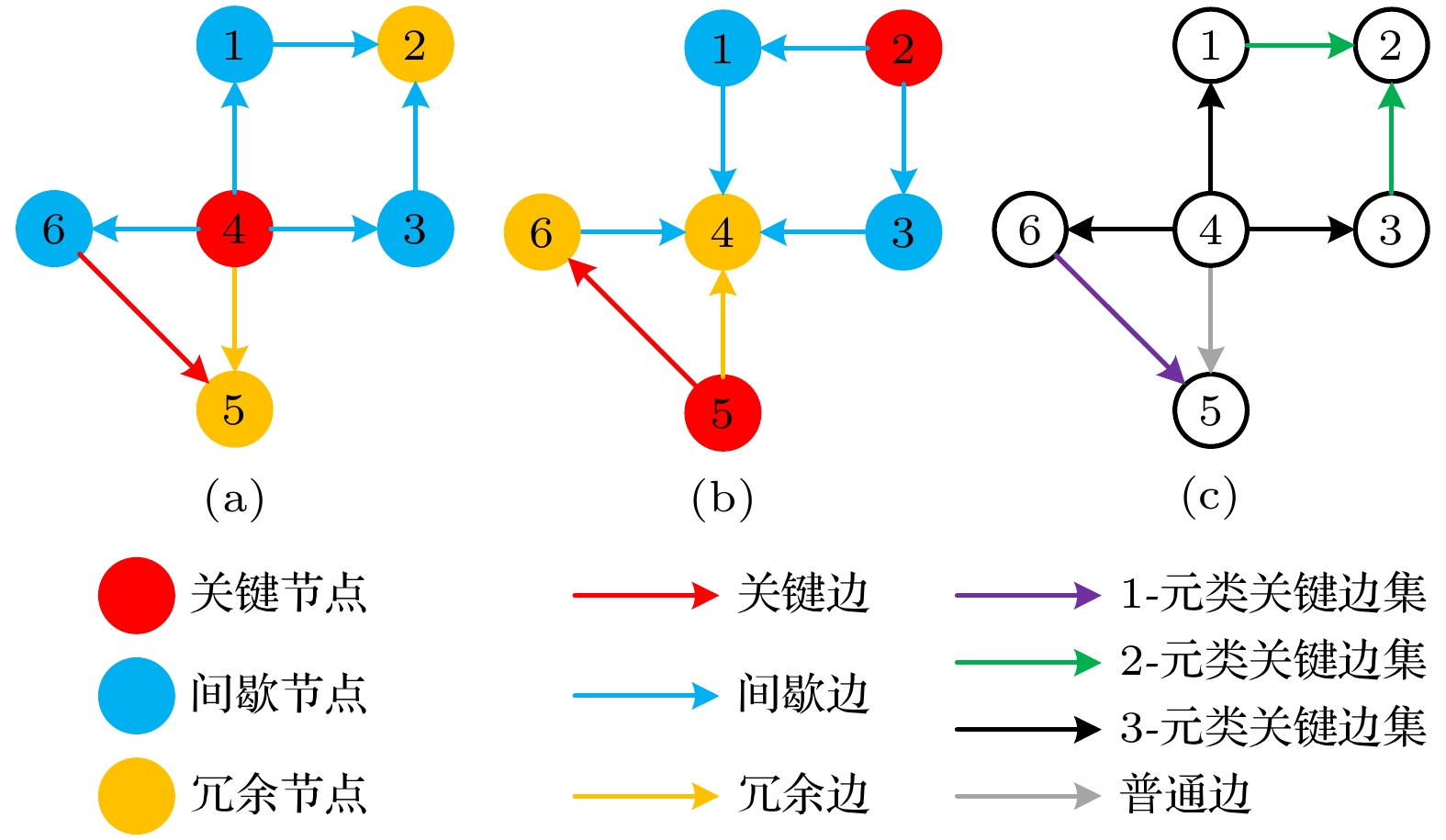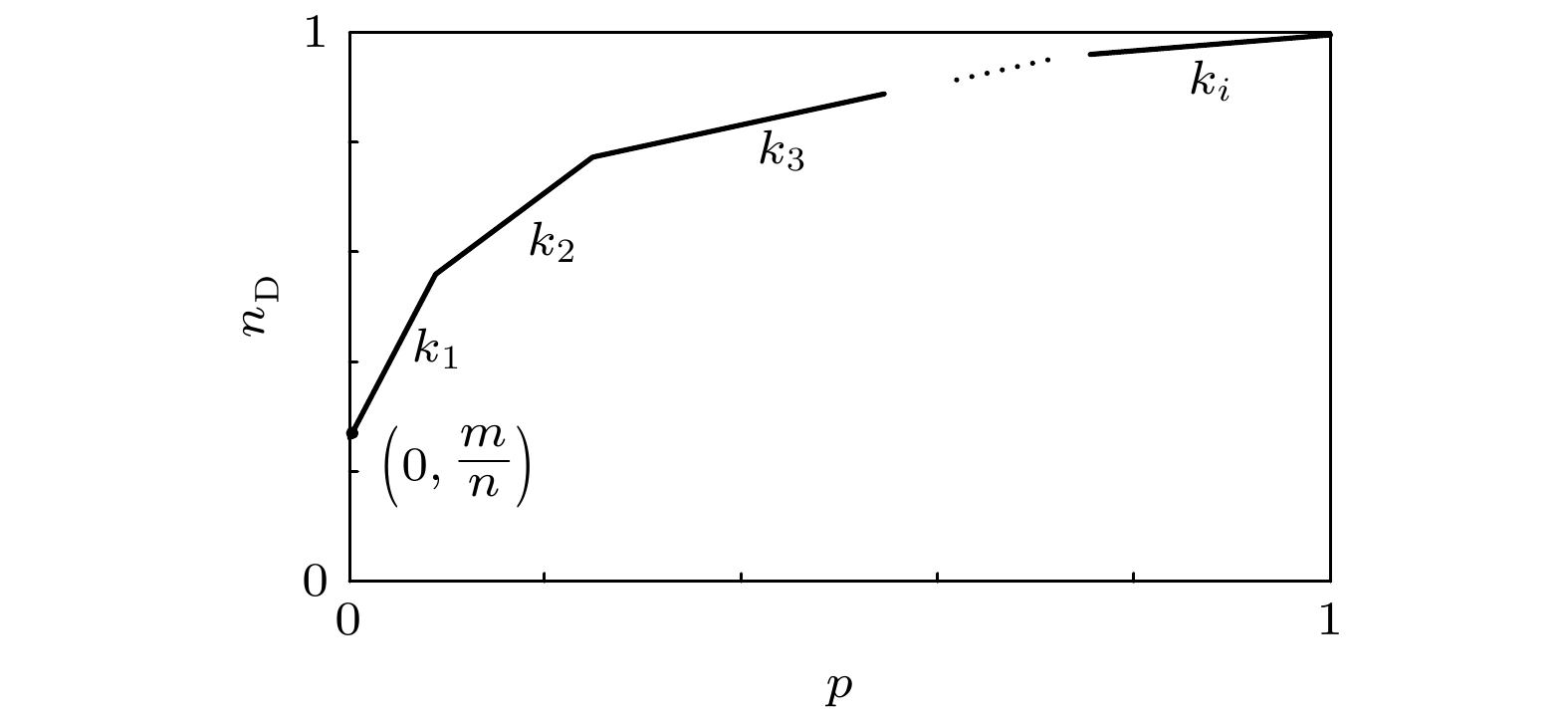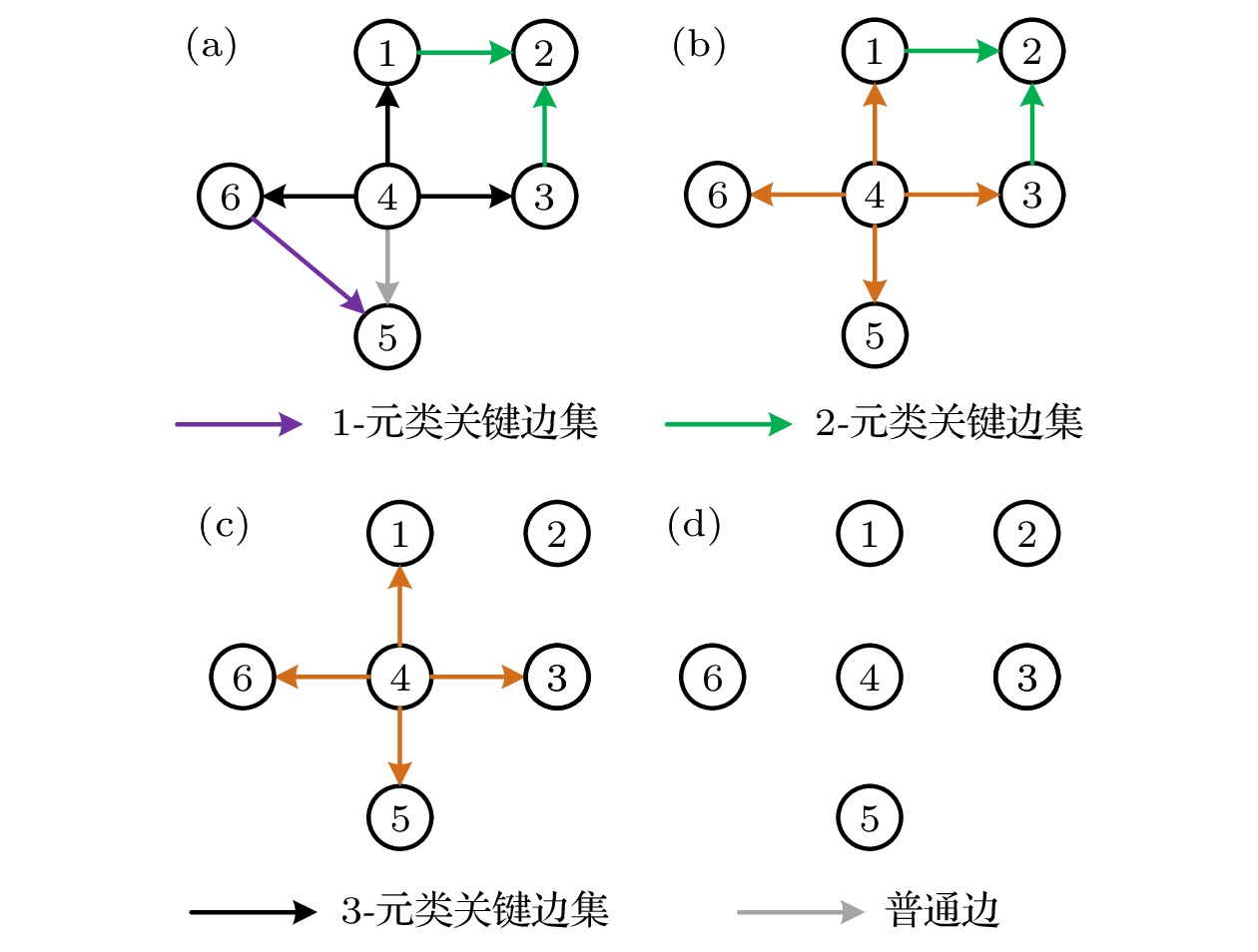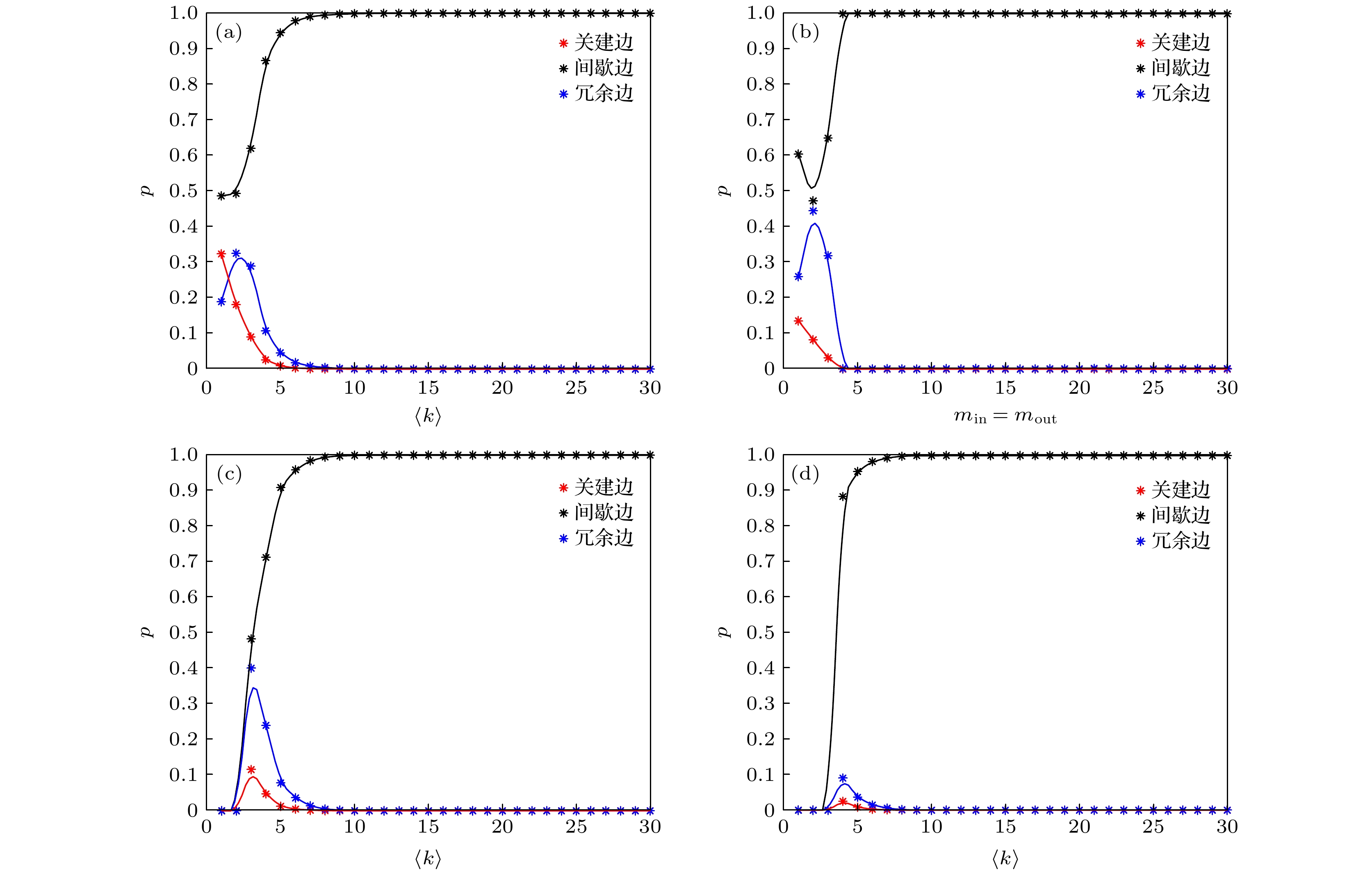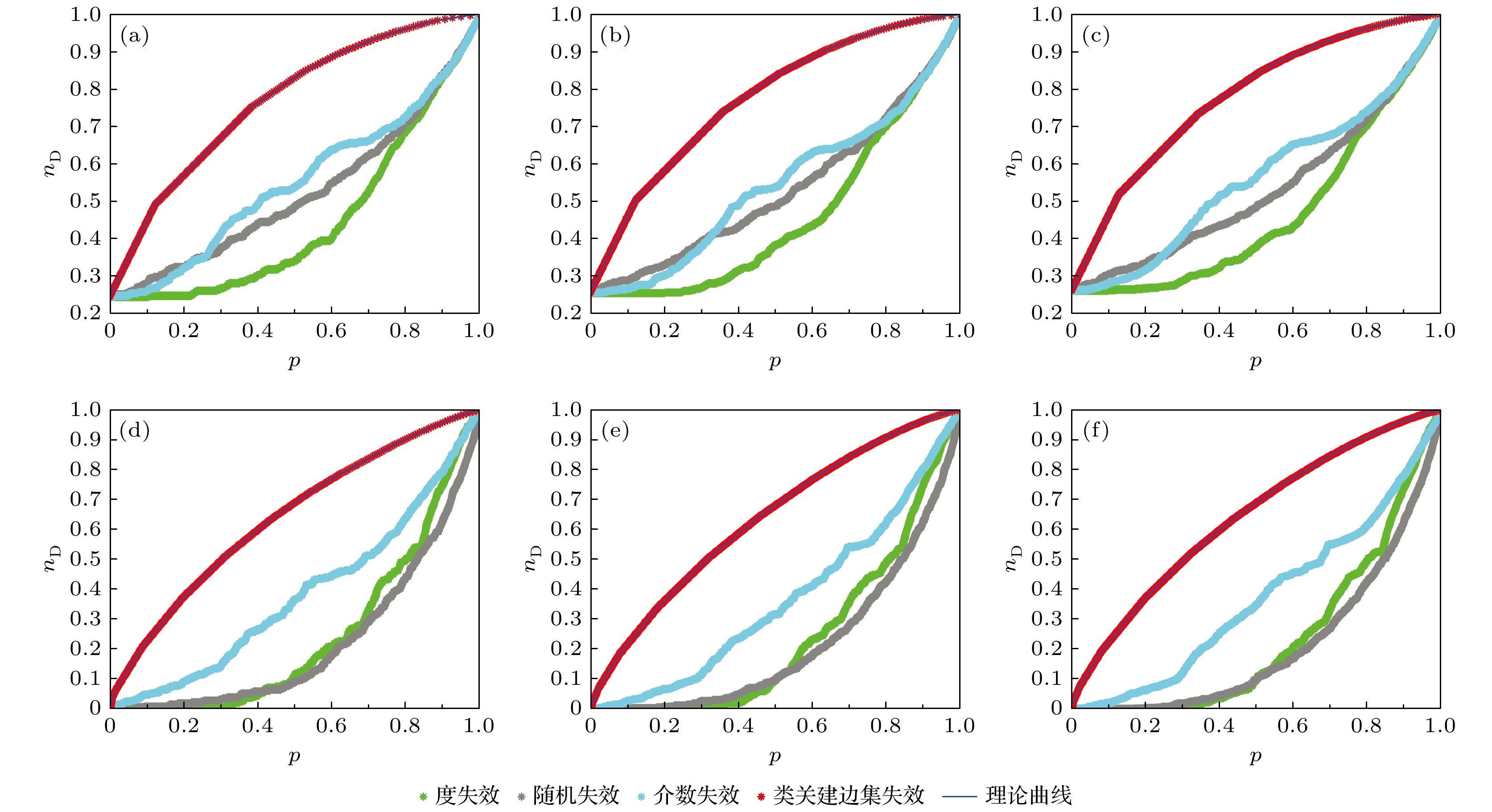-
应用复杂网络描述大规模复杂系统间的相互作用已被广泛接受, 网络中某些边遭受攻击或破坏会使网络不能控. 然而哪些边失效后会对网络能控性造成影响? 针对这一问题, 本文首先提出了类关键边集的概念, 并给出了类关键边集的判定定理. 然后通过建立类关键边集失效模型, 来研究类关键边集失效对网络能控性的影响. 最后将类关键边集失效、随机失效、按度失效和按介数失效进行对比, 验证了无论是在模型网络(ER随机网络、BA无标度网络、随机三角形网络和随机矩形网络), 还是26种不同领域的实际网络中, 类关键边集失效对网络能控性的破坏力最大, 同时该结果为网络边攻击提供了一种新方法.It is undisputed that complex networks are used to describe the interaction between large-scale complex systems. Different edges have different effects on network controllability. When some edges in a network are attacked or destroyed, the network controllability may be affected very little; when some other edges are attacked, network controllability may be affected very greatly, even results in the uncontrollability of the network. Which edges failure will affect the network controllability? To solve this problem, according to the node classification and edge classification, the concept of quasi-critical edge set is proposed, and the judgment theorem of quasi-critical edge set is given in this paper. In order to study the influence of quasi-critical edge set on the network controllability, the failure model of quasi-critical edge set is proposed, and the network controllability is quantified by the ratio of the number of driver nodes to the number of network nodes. In this failure model, the quasi-critical edge set with the minimum number of edges is removed first, thus destroying the network controllability quickly. By analyzing the failure model of quasi-critical edge set, the failure curve of quasi-critical edge set is obtained. It is found that the failure curve is a piecewise linear function and that the maximum (initial) slope of failure curve is related to the average degree of network. In addition, the failure of quasi-critical edge set has the greatest influence on network controllability. A comparison among the failure of quasi-critical edge set, random failure, degree failure, and betweenness failure verifies that the failure of quasi-critical edge set has the greatest damage to the network controllability in both model networks (ER random network, BA scale-free network, random triangle network and random rectangle network) and real networks in 26 different fields. For some of real networks, such as cancer cell networks, terrorist communication networks and other networks that are harmful to human beings, the failure model of quasi-critical edge set can provide a reference attack method.
-
Keywords:
- complex network /
- structural controllability /
- quasi-critical edge set /
- edge failure model
[1] Watts D J, Strogatz S H 1998 Nature 393 440
 Google Scholar
Google Scholar
[2] Barabási A L, Albert R 1999 Science 286 509
 Google Scholar
Google Scholar
[3] 侯绿林, 老松杨, 肖延东, 白亮 2015 64 188901
 Google Scholar
Google Scholar
Hou L L, Lao S Y, Xiao Y D, Bai L 2015 Acta Phys. Sin. 64 188901
 Google Scholar
Google Scholar
[4] 徐明, 许传云, 曹克非 2017 66 028901
 Google Scholar
Google Scholar
Xu M, Xu C Y, Cao K F 2017 Acta Phys. Sin. 66 028901
 Google Scholar
Google Scholar
[5] Lin C T 1974 IEEE Trans. Autom. Control 19 201
 Google Scholar
Google Scholar
[6] Liu Y Y, Slotine J J, Barabrási A L 2011 Nature 473 167
 Google Scholar
Google Scholar
[7] Pequito S, Kar S, Aguiar A P 2016 IEEE Trans. Autom. Control 61 303
 Google Scholar
Google Scholar
[8] Yin H L, Zhang S Y 2016 Physica A 443 467
 Google Scholar
Google Scholar
[9] Yuan Z Z, Zhao C, Di Z R, Wang W X, Lai Y C 2013 Nat. Commun. 4 2447
 Google Scholar
Google Scholar
[10] Olshevsky A 2015 2015 American Control Conference (ACC) Chicago, the United States, July 1–3, 2015 p2218
[11] Olshevsky A 2014 IEEE Trans. Control. Netw. Syst. 1 249
 Google Scholar
Google Scholar
[12] Pang S P, Wang W X, Hao F, Lai Y C 2017 Sci. Rep. 7 4224
 Google Scholar
Google Scholar
[13] Menara T, Bassett D S, Pasqualetti F 2019 IEEE Trans. Autom. Control 64 3740
 Google Scholar
Google Scholar
[14] Lee B H, and Jung W S 2018 Physica A 497 15
 Google Scholar
Google Scholar
[15] Alec K, Hugo B, Marc B, Gourab G 2018 Nat. Commun. 9 2501
 Google Scholar
Google Scholar
[16] Gu S, Pasqualetti F, Cieslak M, et al. 2015 Nat. Commun. 6 8414
 Google Scholar
Google Scholar
[17] Li Y S, Ma D, Zhang H G, Sun Q Y 2015 Appl. Sci. 5 622
 Google Scholar
Google Scholar
[18] Jia T, Liu Y Y, Csóka E, Pósfai M, Slotine J J, Barabási A L 2013 Nat. Commun. 4 2002
 Google Scholar
Google Scholar
[19] Wang J J, Yu X H, Stone L 2016 Sci. Rep. 6 25627
 Google Scholar
Google Scholar
[20] Zhang R, Wang X M, Cheng M, Jia T 2019 Physica A 520 257
 Google Scholar
Google Scholar
[21] Ruths J, Ruths D 2013 Complex Networks IV. Studies in Computational Intelligence (Berlin Heidelberg: Springer) pp185−192
[22] Lu Z M, Li X F 2016 PloS One 11 e0162289
 Google Scholar
Google Scholar
[23] Thomas J, Ghosh S, Parek D, Ruths D, Ruths J 2016 Complex Networks & Their Applications V (Cham, Switzerland: Springer) p525
[24] Chen G R, Lou Y, Wang L 2019 IEEE Trans. Circuits Syst. Express Briefs 66 828
 Google Scholar
Google Scholar
[25] 蒋文君, 刘润然, 范天龙, 刘霜霜, 吕琳媛 2020 69 088904
 Google Scholar
Google Scholar
Jiang W J, Liu R R, Fan T L, Liu S S, Lü L Y 2020 Acta Phys. Sin. 69 088904
 Google Scholar
Google Scholar
[26] 陈世明, 邹小群, 吕辉, 徐青刚 2014 63 028902
 Google Scholar
Google Scholar
Chen S M, Zou X Q, Lü H, Xu Q G 2014 Acta Phys. Sin. 63 028902
 Google Scholar
Google Scholar
[27] Nie S, Wang X W, Zhang H F, Li Q L, Wang B H 2014 PloS One 9 e89066
 Google Scholar
Google Scholar
[28] Lou Y, Wang L, Chen G R 2018 IEEE Trans. Circuits Syst. Regul. Pap. 65 2983
 Google Scholar
Google Scholar
[29] Shang Y L 2019 IEEE Trans. Syst. Man Cybern.-Syst. 49 821
 Google Scholar
Google Scholar
[30] Edmonds J 1965 Can. J. Math. 17 449
 Google Scholar
Google Scholar
[31] Hopcroft J E, Karp R M 1973 SIAM J. Comput. 2 225
[32] Kalman R E 1963 J. Soc. Indus. Appl. Math. Ser. A 1 152
 Google Scholar
Google Scholar
[33] Valiant L G 1979 Theor. Comput. Sci. 8 189
 Google Scholar
Google Scholar
[34] Erdös P, Rényi A 1964 Acta Math. Hung. 12 261
 Google Scholar
Google Scholar
[35] Orsini C, Dankulov M M, Colomer-de-Simón P, et al. 2015 Nat. Commun. 6 8627
 Google Scholar
Google Scholar
[36] Yang D, Chow T W S, Zhang Y C, Chen G R 2017 2017 IEEE 15th International Conference on Industrial Informatics (INDIN) Emden Germany, July 24–26, 2017 p992
[37] Holme P, Kim B J, Yoon C N, Han S K 2002 Phys. Rev. E 65 056109
 Google Scholar
Google Scholar
[38] Nie S, Wang X W, Wang B H, Jiang L L 2016 Sci. Rep. 6 23952
 Google Scholar
Google Scholar
[39] 马秀娟 2012 电子设计工程 20 11
 Google Scholar
Google Scholar
Ma X J 2012 Electronic Design Engineering 20 11
 Google Scholar
Google Scholar
[40] Linton C F http://moreno.ss.uci.edu/data.html [2020-9-15]
-
图 7 不同网络中关键边、间歇边和冗余边占网络总边数的比例随网络度的变化曲线 (a) ER随机网络; (b) BA无标度网络; (c) 随机三角形网络; (d) 随机矩形网络
Fig. 7. Curve of the ratio of critical edge, intermittent edge and redundant edge to the total number of network edges with network degree in different networks: (a) ER random network; (b) BA scale-free network; (c) random triangle network; (d) random rectangle network.
图 8 不同节点总数和平均度的随机网络在4种边失效方式下网络能控性
$n_{\rm D}$ 的变化 (a)节点总数$N=300$ , 平均度$ \left\langle {k_{\rm in}} \right\rangle= \left\langle { k_{ {\rm out}}} \right\rangle=2$ 的随机网络; (b)节点总数$N=500$ , 平均度$\left\langle {k_{\rm in}} \right\rangle= \left\langle { k_{ {\rm out}}} \right\rangle=2$ 的随机网络; (c)节点总数$N=700$ , 平均度$\left\langle {k_{\rm in}} \right\rangle= \left\langle { k_{ {\rm out}}} \right\rangle=2$ 的随机网络; (d)节点总数$N=300$ , 平均度$\left\langle {k_{\rm in}} \right\rangle= \left\langle { k_{ {\rm out}}} \right\rangle=6$ 的随机网络; (e)节点总数$N=500$ , 平均度$\left\langle {k_{\rm in}} \right\rangle= \left\langle { k_{ {\rm out}}} \right\rangle=6$ 的随机网络; (f)节点总数$N=700$ , 平均度$\left\langle {k_{\rm in}} \right\rangle= \left\langle { k_{ {\rm out}}} \right\rangle=6$ 的随机网络Fig. 8. The change of controllability
$n_{\rm D}$ of random networks with different number of nodes and average degree under four kinds of edge failure modes: (a) A random network with number of nodes$N=300$ and average degree$\left\langle {k_{\rm in}} \right\rangle= \left\langle { k_{ {\rm out}}} \right\rangle=2$ ; (b) a random network with number of nodes$N=500$ and average degree$ \left\langle {k_{\rm in}} \right\rangle= \left\langle { k_{ {\rm out}}} \right\rangle=2$ ; (c) a random network with number of nodes$N=700$ and average degree$\left\langle {k_{\rm in}} \right\rangle= \left\langle { k_{ {\rm out}}} \right\rangle=2$ ; (d) a random network with number of nodes$N=300$ and average degree$ \left\langle {k_{\rm in}} \right\rangle= \left\langle { k_{ {\rm out}}} \right\rangle=6$ ; (e) a random network with number of nodes$N=500$ and average degree$\left\langle {k_{\rm in}} \right\rangle= \left\langle { k_{ {\rm out}}} \right\rangle=6$ ; (f) a random network with number of nodes$N=700$ and average degree$\left\langle {k_{\rm in}} \right\rangle= \left\langle { k_{ {\rm out}}} \right\rangle=6$ .图 9 不同节点总数和平均度的无标度网络在4种边失效方式下网络能控性
$n_{\rm D}$ 的变化 (a) 节点总数$N=300$ ,$m_{\rm in}=m_{\rm {out}}=1$ 的无标度网络; (b) 节点总数$N=500$ ,$m_{\rm in}=m_{\rm {out}}=1$ 的无标度网络; (c) 节点总数$N=700$ ,$m_{\rm in}=m_{\rm {out}}=1$ 的无标度网络; (d) 节点总数$N=300$ ,$m_{\rm in}=m_{\rm {out}}=3$ 的无标度网络; (e) 节点总数$N=500$ ,$m_{\rm in}=m_{\rm {out}}=3$ 的无标度网络; (f) 节点总数$N=700$ ,$m_{\rm in}=m_{\rm {out}}=3$ 的无标度网络Fig. 9. The change of controllability
$n_{\rm D}$ of scale-free networks with different number of nodes and average degree under four kinds of edge failure modes: (a) A scale-free network with number of nodes$N=300$ and$m_{\rm in}=m_{\rm {out}}=1$ ; (b) a scale-free network with number of nodes$N=500$ and$m_{\rm in}=m_{\rm {out}}=1$ ; (c) a scale-free network with number of nodes$N=700$ and$m_{\rm in}=m_{\rm {out}}=1$ ; (d) a scale-free network with number of nodes$N=300$ and$m_{\rm in}=m_{\rm {out}}=3$ ; (e) a scale-free network with number of nodes$N=500$ and$m_{\rm in}=m_{\rm {out}}=3$ ; (f) a scale-free network with number of nodes$N=700$ and$m_{\rm in}=m_{\rm {out}}=3$ .图 10 不同节点总数和平均度的随机三角形网络在4种边失效方式下网络能控性
$n_{\rm D}$ 的变化 (a) 节点总数$N=300$ , 平均度$ \left\langle {k_{\rm in}} \right\rangle= \left\langle { k_{ {\rm out}}} \right\rangle=2$ 的随机三角形网络; (b) 节点总数$N=500$ , 平均度$\left\langle {k_{\rm in}} \right\rangle= \left\langle { k_{ {\rm out}}} \right\rangle=2$ 的随机三角形网络; (c) 节点总数$N=700$ , 平均度$ \left\langle {k_{\rm in}} \right\rangle= \left\langle { k_{ {\rm out}}} \right\rangle=2$ 的随机三角形网络; (d) 节点总数$N=300$ , 平均度$ \left\langle {k_{\rm in}} \right\rangle= \left\langle { k_{ {\rm out}}} \right\rangle=6$ 的随机三角形网络; (e) 节点总数$N=500$ , 平均度$\left\langle {k_{\rm in}} \right\rangle= \left\langle { k_{ {\rm out}}} \right\rangle=6$ 的随机三角形网络; (f) 节点总数$N=700$ , 平均度$ \left\langle {k_{\rm in}} \right\rangle= \left\langle { k_{ {\rm out}}} \right\rangle=6$ 的随机三角形网络Fig. 10. The change of controllability
$n_{\rm D}$ of random triangle networks with different number of nodes and average degree under four kinds of edge failure modes: (a) A random triangle network with number of nodes$N=300$ and average degree$ \left\langle {k_{\rm in}} \right\rangle= \left\langle { k_{ {\rm out}}} \right\rangle=2$ ; (b) a random triangle network with number of nodes$N=500$ and average degree$\left\langle {k_{\rm in}} \right\rangle= \left\langle { k_{ {\rm out}}} \right\rangle=2$ ; (c) a random triangle network with number of nodes$N=700$ and average degree$\left\langle {k_{\rm in}} \right\rangle= \left\langle { k_{ {\rm out}}} \right\rangle=2$ ; (d) a random triangle network with number of nodes$N=300$ and average degree$\left\langle {k_{\rm in}} \right\rangle= \left\langle { k_{ {\rm out}}} \right\rangle=6$ ; (e) a random triangle network with number of nodes$N=500$ and average degree$ \left\langle {k_{\rm in}} \right\rangle= \left\langle { k_{ {\rm out}}} \right\rangle=6$ ; (f) a random triangle network with number of nodes$N=700$ and average degree$ \left\langle {k_{\rm in}} \right\rangle= \left\langle { k_{ {\rm out}}} \right\rangle=6$ .图 11 不同节点总数和平均度的随机矩形网络在四4边失效方式下网络能控性
$n_{\rm D}$ 的变化 (a) 节点总数$N=300$ , 平均度$ \left\langle {k_{\rm in}} \right\rangle= \left\langle { k_{ {\rm out}}} \right\rangle=2$ 的随机矩形网络; (b) 节点总数$N=500$ , 平均度$\left\langle {k_{\rm in}} \right\rangle= \left\langle { k_{ {\rm out}}} \right\rangle=2$ 的随机矩形网络; (c) 节点总数$N=700$ , 平均度$ \left\langle {k_{\rm in}} \right\rangle= \left\langle { k_{ {\rm out}}} \right\rangle=2$ 的随机矩形形网络; (d) 节点总数$N=300$ , 平均度$ \left\langle {k_{\rm in}} \right\rangle= \left\langle { k_{ {\rm out}}} \right\rangle=6$ 的随机矩形网络; (e) 节点总数$N=500$ , 平均度$ \left\langle {k_{\rm in}} \right\rangle= \left\langle { k_{ {\rm out}}} \right\rangle=6$ 的随机矩形网络; (f) 节点总数$N=700$ , 平均度$\left\langle {k_{\rm in}} \right\rangle= \left\langle { k_{ {\rm out}}} \right\rangle=6$ 的随机矩形网络Fig. 11. The change of controllability
$n_{\rm D}$ of random rectangle networks with different number of nodes and average degree under four kinds of edge failure modes: (a) A random rectangle network with number of nodes$N=300$ and average degree$\left\langle {k_{\rm in}} \right\rangle= \left\langle { k_{ {\rm out}}} \right\rangle=2$ ; (b) a random rectangle network with number of nodes$N=500$ and average degree$ \left\langle {k_{\rm in}} \right\rangle= \left\langle { k_{ {\rm out}}} \right\rangle=2$ ; (c) a random rectangle network with number of nodes$N=700$ and average degree$ \left\langle {k_{\rm in}} \right\rangle= \left\langle { k_{ {\rm out}}} \right\rangle=2$ ; (d) a random rectangle network with number of nodes$N=300$ and average degree$\left\langle {k_{\rm in}} \right\rangle= \left\langle { k_{ {\rm out}}} \right\rangle=6$ ; (e) a random rectangle network with number of nodes$N=500$ and average degree$ \left\langle {k_{\rm in}} \right\rangle= \left\langle { k_{ {\rm out}}} \right\rangle=6$ ; (f) a random rectangle network with number of nodes$N=700$ and average degree$ \left\langle {k_{\rm in}} \right\rangle= \left\langle { k_{ {\rm out}}} \right\rangle=6$ .表 1 实际网络中4种边失效对能控性的影响
Table 1. Influence of four edge failures on controllability in real networks.
网络 N L $n_{\rm D}$ 边移除比例$ p $后网络的$n_{\rm D}$ p = 0.2 p = 0.5 p = 0.8 随机 按度 按介数 FQ 随机 按度 按介数 FQ 随机 按度 按介数 FQ Electronic Circuits_S208 122 189 0.24 0.33 0.29 0.43 0.53 0.48 0.57 0.56 0.77 0.74 0.84 0.85 0.95 Electronic Circuits_S402 252 399 0.23 0.32 0.30 0.42 0.53 0.52 0.56 0.57 0.77 0.76 0.84 0.84 0.95 Electronic Circuits_S838 512 819 0.23 0.33 0.30 0.42 0.53 0.48 0.55 0.57 0.77 0.74 0.84 0.84 0.95 Animal_Hens 32 496 0.03 0.03 0.25 0.19 0.44 0.03 0.59 0.34 0.69 0.19 0.81 0.63 0.88 Collaboration_in jazz 198 5484 0.01 0.01 0.01 0.14 0.43 0.03 0.02 0.32 0.72 0.08 0.38 0.60 0.91 Joint senate press releases 92 954 0.01 0.01 0.01 0.22 0.48 0.07 0.01 0.42 0.76 0.27 0.36 0.53 0.92 Questionnaire for high tech managers_Advice 21 190 0.05 0.05 0.14 0.19 0.43 0.10 0.38 0.43 0.67 0.29 0.62 0.67 0.86 Questionnaire for high tech managers_Friendship 21 102 0.10 0.19 0.14 0.33 0.52 0.24 0.43 0.67 0.76 0.57 0.71 0.86 0.90 Questionnaire for high tech managers_Reports 21 20 0.76 0.76 0.81 0.81 0.81 0.76 0.81 0.81 0.90 0.86 0.86 0.86 0.95 corporate law partnership_law firm 71 892 0.01 0.03 0.04 0.20 0.46 0.06 0.20 0.31 0.73 0.25 0.56 0.65 0.90 Children's network of friendship_Third grade 22 177 0.05 0.05 0.05 0.18 0.36 0.05 0.27 0.27 0.64 0.36 0.68 0.64 0.86 Children's network of friendship_Fourth grade 24 101 0.04 0.04 0.08 0.17 0.29 0.42 0.25 0.33 0.58 0.50 0.71 0.58 0.83 Children's network of friendship_Fifth grade 22 103 0.05 0.05 0.09 0.23 0.36 0.18 0.23 0.41 0.68 0.50 0.64 0.73 0.86 Questionnaire for bank_Advice-seeking 11 30 0.27 0.36 0.45 0.36 0.55 0.45 0.55 0.55 0.73 0.73 0.73 0.73 0.91 Questionnaire for bank_Satisfying 11 51 0.18 0.27 0.27 0.36 0.55 0.36 0.36 0.55 0.73 0.64 0.73 0.64 0.82 Questionnaire for bank_Confiding 11 27 0.18 0.27 0.27 0.36 0.55 0.36 0.45 0.55 0.73 0.64 0.82 0.82 0.91 Questionnaire for bank_Close-friends 11 20 0.36 0.45 0.36 0.45 0.55 0.55 0.64 0.54 0.82 0.82 0.82 0.73 0.91 Trade goods in different countries_Foods 24 307 0.04 0.04 0.08 0.21 0.38 0.04 0.17 0.33 0.67 0.17 0.67 0.58 0.88 Trade goods in different countries_Crude materials 24 307 0.04 0.04 0.04 0.21 0.38 0.04 0.21 0.29 0.71 0.17 0.54 0.71 0.88 Trade goods in different countries_Minerals 24 135 0.13 0.13 0.17 0.38 0.58 0.29 0.50 0.58 0.79 0.58 0.83 0.88 0.92 Trade goods in different countries_Diplomacy 24 369 0.04 0.04 0.04 0.21 0.29 0.04 0.12 0.33 0.58 0.12 0.63 0.75 0.83 Questionnaire for grade seven students_Get on 29 361 0.03 0.03 0.03 0.21 0.34 0.03 0.10 0.34 0.65 0.10 0.52 0.59 0.90 Questionnaire for grade seven students_Best friends 29 181 0.03 0.03 0.03 0.17 0.45 0.14 0.21 0.45 0.72 0.48 0.59 0.62 0.93 Questionnaire for grade seven students_Work with 29 198 0.03 0.07 0.10 0.21 0.45 0.21 0.21 0.41 0.72 0.41 0.59 0.62 0.90 Friendships among high school boys_1957 73 243 0.18 0.25 0.19 0.29 0.53 0.34 0.34 0.49 0.77 0.63 0.67 0.78 0.92 Friendships among high school boys_1958 73 263 0.15 0.19 0.15 0.25 0.52 0.29 0.27 0.47 0.77 0.55 0.64 0.78 0.93 -
[1] Watts D J, Strogatz S H 1998 Nature 393 440
 Google Scholar
Google Scholar
[2] Barabási A L, Albert R 1999 Science 286 509
 Google Scholar
Google Scholar
[3] 侯绿林, 老松杨, 肖延东, 白亮 2015 64 188901
 Google Scholar
Google Scholar
Hou L L, Lao S Y, Xiao Y D, Bai L 2015 Acta Phys. Sin. 64 188901
 Google Scholar
Google Scholar
[4] 徐明, 许传云, 曹克非 2017 66 028901
 Google Scholar
Google Scholar
Xu M, Xu C Y, Cao K F 2017 Acta Phys. Sin. 66 028901
 Google Scholar
Google Scholar
[5] Lin C T 1974 IEEE Trans. Autom. Control 19 201
 Google Scholar
Google Scholar
[6] Liu Y Y, Slotine J J, Barabrási A L 2011 Nature 473 167
 Google Scholar
Google Scholar
[7] Pequito S, Kar S, Aguiar A P 2016 IEEE Trans. Autom. Control 61 303
 Google Scholar
Google Scholar
[8] Yin H L, Zhang S Y 2016 Physica A 443 467
 Google Scholar
Google Scholar
[9] Yuan Z Z, Zhao C, Di Z R, Wang W X, Lai Y C 2013 Nat. Commun. 4 2447
 Google Scholar
Google Scholar
[10] Olshevsky A 2015 2015 American Control Conference (ACC) Chicago, the United States, July 1–3, 2015 p2218
[11] Olshevsky A 2014 IEEE Trans. Control. Netw. Syst. 1 249
 Google Scholar
Google Scholar
[12] Pang S P, Wang W X, Hao F, Lai Y C 2017 Sci. Rep. 7 4224
 Google Scholar
Google Scholar
[13] Menara T, Bassett D S, Pasqualetti F 2019 IEEE Trans. Autom. Control 64 3740
 Google Scholar
Google Scholar
[14] Lee B H, and Jung W S 2018 Physica A 497 15
 Google Scholar
Google Scholar
[15] Alec K, Hugo B, Marc B, Gourab G 2018 Nat. Commun. 9 2501
 Google Scholar
Google Scholar
[16] Gu S, Pasqualetti F, Cieslak M, et al. 2015 Nat. Commun. 6 8414
 Google Scholar
Google Scholar
[17] Li Y S, Ma D, Zhang H G, Sun Q Y 2015 Appl. Sci. 5 622
 Google Scholar
Google Scholar
[18] Jia T, Liu Y Y, Csóka E, Pósfai M, Slotine J J, Barabási A L 2013 Nat. Commun. 4 2002
 Google Scholar
Google Scholar
[19] Wang J J, Yu X H, Stone L 2016 Sci. Rep. 6 25627
 Google Scholar
Google Scholar
[20] Zhang R, Wang X M, Cheng M, Jia T 2019 Physica A 520 257
 Google Scholar
Google Scholar
[21] Ruths J, Ruths D 2013 Complex Networks IV. Studies in Computational Intelligence (Berlin Heidelberg: Springer) pp185−192
[22] Lu Z M, Li X F 2016 PloS One 11 e0162289
 Google Scholar
Google Scholar
[23] Thomas J, Ghosh S, Parek D, Ruths D, Ruths J 2016 Complex Networks & Their Applications V (Cham, Switzerland: Springer) p525
[24] Chen G R, Lou Y, Wang L 2019 IEEE Trans. Circuits Syst. Express Briefs 66 828
 Google Scholar
Google Scholar
[25] 蒋文君, 刘润然, 范天龙, 刘霜霜, 吕琳媛 2020 69 088904
 Google Scholar
Google Scholar
Jiang W J, Liu R R, Fan T L, Liu S S, Lü L Y 2020 Acta Phys. Sin. 69 088904
 Google Scholar
Google Scholar
[26] 陈世明, 邹小群, 吕辉, 徐青刚 2014 63 028902
 Google Scholar
Google Scholar
Chen S M, Zou X Q, Lü H, Xu Q G 2014 Acta Phys. Sin. 63 028902
 Google Scholar
Google Scholar
[27] Nie S, Wang X W, Zhang H F, Li Q L, Wang B H 2014 PloS One 9 e89066
 Google Scholar
Google Scholar
[28] Lou Y, Wang L, Chen G R 2018 IEEE Trans. Circuits Syst. Regul. Pap. 65 2983
 Google Scholar
Google Scholar
[29] Shang Y L 2019 IEEE Trans. Syst. Man Cybern.-Syst. 49 821
 Google Scholar
Google Scholar
[30] Edmonds J 1965 Can. J. Math. 17 449
 Google Scholar
Google Scholar
[31] Hopcroft J E, Karp R M 1973 SIAM J. Comput. 2 225
[32] Kalman R E 1963 J. Soc. Indus. Appl. Math. Ser. A 1 152
 Google Scholar
Google Scholar
[33] Valiant L G 1979 Theor. Comput. Sci. 8 189
 Google Scholar
Google Scholar
[34] Erdös P, Rényi A 1964 Acta Math. Hung. 12 261
 Google Scholar
Google Scholar
[35] Orsini C, Dankulov M M, Colomer-de-Simón P, et al. 2015 Nat. Commun. 6 8627
 Google Scholar
Google Scholar
[36] Yang D, Chow T W S, Zhang Y C, Chen G R 2017 2017 IEEE 15th International Conference on Industrial Informatics (INDIN) Emden Germany, July 24–26, 2017 p992
[37] Holme P, Kim B J, Yoon C N, Han S K 2002 Phys. Rev. E 65 056109
 Google Scholar
Google Scholar
[38] Nie S, Wang X W, Wang B H, Jiang L L 2016 Sci. Rep. 6 23952
 Google Scholar
Google Scholar
[39] 马秀娟 2012 电子设计工程 20 11
 Google Scholar
Google Scholar
Ma X J 2012 Electronic Design Engineering 20 11
 Google Scholar
Google Scholar
[40] Linton C F http://moreno.ss.uci.edu/data.html [2020-9-15]
计量
- 文章访问数: 5531
- PDF下载量: 73
- 被引次数: 0














 下载:
下载:

